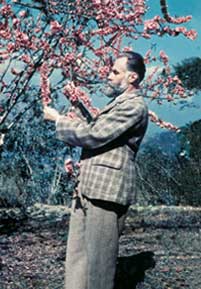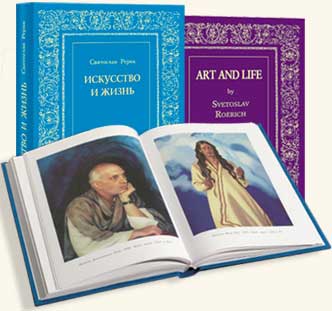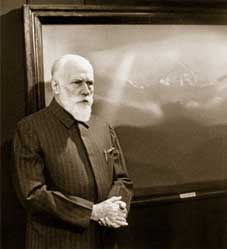From 1931, living permanently in India, Svetoslav Roerich actively participated in its public and cultural life. He loved that country dearly and it became his second Motherland. In many of his wonderful canvases, Svetoslav Roerich sang the praises of India’s unique beauty, diversity of cultural traditions, and subtleness of spiritual achievements. That is why the honor to call S. Roerich its national pride befalls not only on Russia alone, but on India as well. After 1947, S. Roerich conducted a lot of work related to the signing of Roerich’s Pact by the Indian Government. “I am happy to note that the attitude of the Indian Government towards the aims we keep in mind is sympathetic, and it approves of Roerich’s Pact <…> I wish so much now that it be this country and at this time that could become an active fighter for the cultural principles contained in this Pact <…>”[4, p.325-326], S. Roerich wrote to one of the Indian leaders H. Kabiru. Thanks to S. Roerich’s efforts, in August 1948, India signed this document. During the following years, S. Roerich actively participated in the work on the preservation and protection from destruction of the ancient Indian cultural monuments; he organized committees, and urged the Governments of Indian States to take concrete steps in this direction. In July of 1941, after Germany attacked the Soviet Union, Svetoslav Roerich sent a telegram to the USSR Ambassador in London, I. Maisky, about his decision to join the Red Army, but he received a refusal. Nevertheless, during the years of the Second World War, Svetoslav Roerich transferred the funds from paintings’ and exhibitions’ sales to the USSR Red Cross.
Svetoslav Roerich took active part in the work of the Institute of Himalayan Studies “Urusvati”. While he was in charge of work of the Natural Department, he carried out unique researches in various fields of the natural sciences. The gift of spiritual synthesis that he possessed contributed to this end. At the basis of S. Roerich’s natural scientific interests lay his deep philosophic understanding of nature as a whole, inalienably connected with the most important cosmic laws. The circle of his scientific interests is striking: ornithology, botany, mineralogy, Tibetan pharmacopoeia, chemistry and its alchemical sources, astrology, comparative religious studies and philosophy, art studies, cultural studies. Such versatile activities of S. Roerich, the scientist, testify to his undoubted belonging to the galaxy of major natural scientists. All S. Roerich’s artistic and literary creative work, as well as his scientific, pedagogical, and public activities are inseparably connected with the ideas of the Living Ethics. To say that Svetoslav Roerich was just its follower would be to oversimplify his role. He was not only the follower of this philosophic system, but a profound thinker, who could develop its most important provisions and ideas. Many of Svetoslav Roerich’s philosophical reflections are dedicated to the great role of art in the creation of a more perfected, high-spirited and virtuous man. These thoughts not only were reflected within the pages of his essays and diaries, but also within the entirety of the painter’s creative and artistic work. "<...> the truth is in Beauty, one of the Living Ethics books says. Cosmos bases evolution on this formula. Cosmos directs the world to mastering Beauty”[5, 178]. Beauty together with its essence and its role in the evolutionary development of mankind, as well as the energetic processes related to it comprised the bases for S. Roerich’s philosophic views. He himself, as an artist and thinker, was attracted first of all to the Beauty created by man. “Great creations are storages of enormous energies, which can activate and change millions of spectators, influence numberless generations through the message of beauty emanating from them. <…> Inexpressible aura of glory is irradiated by a great piece of art, Svetoslav Roerich said. – This is emanation of concealed vibrations fixed in the structure of a great creation. Magic of feelings, thoughts, and strong desires of great masters is captured in a piece of art, is irradiated on the spectator, and awakens in us similar emotional response, beside purely energetic and spiritual understanding of what is spoken about. We respond to more perfect combinations and call them beautiful. <…> Such is the extraordinary power of art, hidden strength, always present and active in a great creation”[6, p.61-64]. Svetoslav Roerich was convinced that Beauty could not be created without a higher ideal. Destruction of this ideal – spiritual or aesthetic – would result in the disfigurement of life and in the loss of its evolutionary pivot. All his life he remained interested in the problems of a more perfected upbringing of man. In response to this, the painter took active part in the work of the children’s school of Bangalore (India) established in 1962 according to the teachings of the Indian philosopher Aurobindo Ghosh. Children were accepted in that school from the age of three. The school’s pedagogical conception was based on the moral and ethical upbringing of children according to especially elaborated methods. From a very early age, these children were acquainted with the ideas of major philosophers, including Helena and Nicholas Roerich’s, with considerable attention given to an artistic education. Annual children’s drawing competitions contributed to this. Svetoslav Roerich noted: “In our pedagogical work in Bangalore, we are trying to lead the new generation along the paths of ascent from the very beginning, give thoughts, ideas of big philosophers from the very early years. <…> Our education must be such, so that when leaving the school the person could be strong, could resist evil, imperfection”[7, p.89-90]. Starting from 1977, S. Roerich supported the school financially.
Svetoslav Roerich is well known as the founder and Honorary President of the cultural and educational Center for the Arts “Chitrakala Parishad” that was established in Bangalore in 1972 and became the local university department. For outstanding achievements in the field of culture, and for his contribution to the cause of peace, S. Roerich received governmental awards from various countries, including the highest civil order of India “Padma Bhushan”, the Soviet order “Friendship of Peoples” and the order “Madar Cavalryman” established by the State Council of Bulgaria. Svetoslav Roerich was a winner of J. Nehru’s International Award; he was awarded the Knighthood of the Bulgarian Order of Kirill and Methody as well as Honorary Membership of the USSR Academy of Arts and the title of Honorary Doctor of the Velikotyrn University of Bulgaria and of Academician of the Academy of Fine Arts of India. However, Svetoslav Roerich considered the award established by the Nicholas Roerich Museum in New York the most outstanding award of his life, since the diploma linked to it had been signed by Nicholas Roerich. The first exhibition of S. Roerich’s paintings was opened in his Motherland on May 11th, 1960, in the A. Pushkin State Museum of Fine Arts. A month later, the artist’s paintings would be exhibited for the visitors of the Leningrad Hermitage. Starting with the 1970es, exhibitions of his paintings were regularly organized in the cities of the Soviet Union. In 1989 in Moscow, on Svetoslav Roerich’s initiative, the Soviet Roerich Foundation was established (since 1991 renamed the International Center of the Roerichs), of which Svetoslav Roerich would remain the Honorary President to the present day. In March 1990, acting according to his parents’ will, he passed onto the SRF the priceless legacy of his family – paintings, objects of fine and applied arts, archival material, a library, and personal belongings. All this constituted the basis for the permanent exhibition of the Nicholas Roerich Public Museum, the initiatives of which are based on the principles laid down by Svetoslav Roerich. S. Roerich passed away on January 30, 1993.
|
| |||||||||||||||||||||
Copyright © 2008-2024 ST. PETERSBURG BRANCH OF THE INTERNATIONAL CENTER OF THE ROERICHS
Life and creative work of Nicholas Roerich | Exhibitions | Excursions | Scientific research | Protection of the Roerichs' name and heritage



